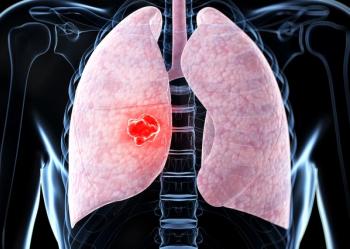
Experts in Treating EGFR-Positive NSCLC Compare Randomized Trials and Real-World Studies
Lyudmila A. Bazhenova, MD, and Federico Albrecht, MD, spoke about treating patients with EGFR-positive non–small cell lung cancer through randomized clinical trials and real-world studies.
Since randomized clinical trials typically focus on a narrow patient population due to rigid exclusion criteria, real-world studies have grown in popularity, encompassing a broader range of patients to uncover insights on a specific treatment modality.1
A study published in Future Oncology dissected the advantages and disadvantages of real-world studies and offered ideas for how oncologists can use the results to help their patients.
In a recent Between the Lines program hosted by CancerNetwork®, Lyudmila A. Bazhenova, MD, and Federico Albrecht, MD, discussed the research, which included the benefits and limitations from examples of real-world studies in EGFR-mutant non–small cell lung cancer (NSCLC).
“We always first refer to randomized clinical trials or prospective clinical trials, [but] real-world evidence has recently came to view and we’re starting to use it a bit more frequently than before,” Bazhenova, a professor of medicine at the University of California San Diego Health, explained. “And I think it’s important for us to understand the difference between a randomized clinical trial and real-world studies.”
“It’s important to acknowledge that randomized controlled trial [are] the gold standard,” Albrecht, an oncologist/hematologist at Miami Cancer Institute, a part of Baptist Health South Florida, explained. “We all know that it’s a gold standard for evidence-based medicine, and this is how we advance science. But the problem is that we need to also understand the limitations of those randomized control trials.”
Randomized Clinical Trials vs Real-World Studies
Although both provide beneficial information, randomized clinical trials and real-world studies have significant differences that cannot be ignored, the first being “purpose” as described by Bazhenova. “The key purpose of the randomized clinical trial is to find out if the drug works; we’re asking for efficacy. In the real-world evidence, we’re asking for effectiveness, which is efficacy in a real-world setting.” In the paper, the authors noted that the differences can be described with the 2 questions, “does it work?” vs “does it work in routine clinical practice?”
Randomized clinical trials are interventional and prospective whereas real-world studies are observational and can be both prospective and retrospective. Further, randomized clinical trials are narrow, restricted, and homogenous compared with the diverse, large, heterogenous real-world studies.
Regarding real-world studies, Bazhenova said, “It’s more representative of what actually happens in the real life. Eligibility criteria in randomized clinical trials is very strict. [With] real-world evidence, you might not even have any eligibility criteria. You just want to follow how your population did in a real practice.”
Treatments are fixed in clinical trials with standard-of-care or placebo comparator arms vs being variable in real-world studies. In real-world studies, Bazhenova explained, “[data] can compare how 2 different patient populations did, but it’s not really a true comparator arm.”
Within the realm of real-world studies, various subtypes exist, each with their own unique characteristics, according to Bazhenova (Table).1
Evidence for Benefits of Real-World Studies
The panelists looked to the phase 3 FLAURA trial (NCT02296125) of osimertinib (Tagrisso) vs first- or second-generation EGFR inhibitors for frontline EGFR-mutant NSCLC that was published in the New England Journal of Medicine2 and for which octogenarians were excluded from participating. This group of patients were evaluated in the real-world OCTOMUT study that same year to assess efficacy and treatment tolerance of first- and second-generation EGFR tyrosine kinase inhibitors (TKIs).3
Bazhenova explained that this is an example of how a real-world study could certainly supplement a randomized clinical trial. “Elderly patients are not included in a clinical trial frequently, so having real-world evidence here is very helpful because it describes to you how the people with advanced age, or octogenarians, do with the same medications that were tested in a clinical trial.”
Real-world data can be useful in determining effectiveness in other subgroups, as Albrecht explains. “[For] common mutations and patients with poor performance status, real-world evidence has helped me in making decisions for those specific groups not included in the randomized clinical trials,” he said.
In another example, Albrecht compared randomized evidence of afatinib (Gilotrif) efficacy for patients with EGFR mutation–positive lung adenocarcinoma—which was assessed in the phase 3 LUX-Lung 3 (NCT00949650) and LUX-Lung 6 (NCT01121393) trial4—with a real-world study. The RealGiDo real-world study showed that toxicities did not increase among patients by subgroup and treatment remained effective with TKI dose reductions.5
“In this way, we know when we encounter these types of patients that we can feel reassured. We can be assured that with this type of information, we know that we can treat those patients in our clinic. This is an example whereby with this real-world evidence, you can actually have a TKI and know that that patient may benefit from it,” Albrecht explained.
Future of Real-World Studies
“Real-world evidence will provide complimentary data to these randomized clinical trials in real-world events, meaning that will include all those patients who were not incorporated into the randomized clinical trial,” Albrecht explained.
Although real-world studies have their benefits, there are limitations that also exist. Specifically, electronic data can be inconsistently collected in real-world studies, potentially reducing clinical validity.1
“Many times, we don’t know where exactly to put the information. But as long as we do a good collection of information from those electronical medical records, that is probably the best source we’re going to have because we can see what happened with real patients with many characteristics. We can group these patients prospectively and reach conclusions and interpretations from this data.”
There also exists the potential for randomized clinical trials and real-world studies to generate disputing results, making direct comparisons between each difficult.
“Based on the search you do, and the experience you have, you’re going to put everything together and make a decision,” Albrecht explained. “Both [randomized clinical trials and real-world studies] give you good, complementary information, and that will give you more and more information for those patients that were not incorporated in randomized clinical trials. Those real-world observational prospective studies are here to stay.”
References
- Nazha B, Yang JC, Owonikoko TK. Benefits and limitations of real-world evidence: lessons from EGFR mutation-positive non-small-cell lung cancer. Future Oncol. 2021;17(8):965-977. doi:10.2217/fon-2020-0951
- Soria JC, Ohe Y, Vansteenkiste J, et al. Osimertinib in untreated EGFR-mutated advanced non-small-cell lung cancer. N Engl J Med. 2018;378(2):113-125. doi:10.1056/NEJMoa1713137
- Corre R, Gervais R, Guisier F, et al. Octogenarians with EGFR-mutated non-small cell lung cancer treated by tyrosine-kinase inhibitor: a multicentric real-world study assessing tolerance and efficacy (OCTOMUT study). Oncotarget. 2018;9(9):8253-8262. doi:10.18632/oncotarget.23836
- Yang JC, Wu YL, Schuler M, et al. Afatinib versus cisplatin-based chemotherapy for EGFR mutation-positive lung adenocarcinoma (LUX-Lung 3 and LUX-Lung 6): analysis of overall survival data from two randomised, phase 3 trials. Lancet Oncol. 2015;16(2):141-151. doi:10.1016/S1470-2045(14)71173-8
- Halmos B, Tan EH, Soo RA, et al. Impact of afatinib dose modification on safety and effectiveness in patients with EGFR mutation-positive advanced NSCLC: Results from a global real-world study (RealGiDo). Lung Cancer. 2019;127:103-111. doi:10.1016/j.lungcan.2018.10.028
Newsletter
Stay up to date on recent advances in the multidisciplinary approach to cancer.















































































